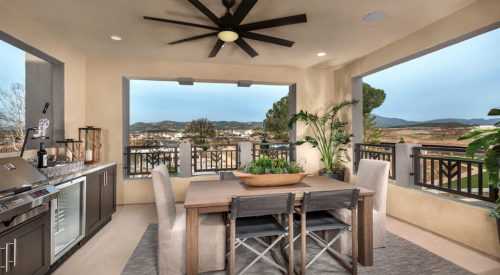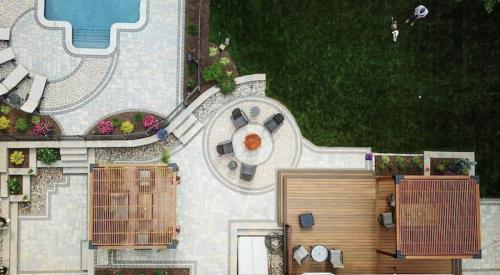Our lives get busier and busier. We don't have enough time to relax. Tension builds. People get sick. Missing work causes more stress. "The statistic we've come up with says between 75 and 95 percent of all doctor visits in this country are related to stress," says Georganne Derick, president of Merchandising East, a company specializing in interior design for model homes. "We are addicted, as a nation, to stress hormones, and they are very harmful over the long-term."
The solution, Ellicott City, Md.-based Derick says, is "creating outdoor rooms where one can get away. Just the experience of being outside and being exposed to sun, breeze and rain pattering on a roof is very calming." Hence, the outdoor oasis arises.
Outdoor rooms can be fun, fancy and free. The range of opportunity depends on the home's style, available land, lot location, the designer's imagination and what the buyer wants. One thing is certain: buyers want them, and more builders are delivering the outdoor rooms customers crave.
Why is there such a strong trend? Barry Glantz, president of Glantz & Associates Architects of St. Louis, Mo., says, "It's the indoor/outdoor connection. It's an extension of the living space."
Braving the ElementsFor decades, designers have used natural materials indoors to create pleasing environments. Now those same materials are being matched in their natural environment.
"If it's an exterior material, like a stone or slate on a wall, we'll try and repeat that in the outdoor room," says Chip Pierson, principal and general manager for Dahlin Group Architecture Planning in San Ramon, Calif. "If it's a hard surface in the living areas on the floor, we'll try and repeat that outside as well."
Using natural materials also follows the feng shui philosophy of balancing the five major elements: water, wood, fire, metal and earth. These elements create a balance in the outdoor spaces, producing an energy flow.
Whether or not you ascribe to the feng shui design ideas, consider what each element adds to an outdoor room:
- The water of a fountain or pool is soothing.
- Wood furniture provides durability and natural ruggedness.
- Stone matches the surrounding environment, reinforcing the outdoor feel.
The earth can be represented by decorative plants and flowers, giving a more complete sense of the outdoors.
- Fire brings the drama and a focal point with a hearth or fire grid.
- Metals in furniture — as decorative elements or as part of the structure — provide the same balance and design tension they do in indoor environments.
Due to climate differences, outdoor rooms require different designs. In fact, the name "outdoor room" can be debated. Some are courtyards, others are patios, and many are simple porches. However they're viewed, these spaces are built to provide a sense of comfort as well as a place to entertain.
"It's not just a porch outside or sitting under a tree," says Brian Van Bower, president of Murfreesboro, Tenn.-based Genesis 3 and Aquatic Consultants of Miami. Outdoor rooms "are a way of having space where one might sit outside for the whole evening or have people over and go right outside to entertain there."
In Southern California, the climate is conducive to courtyards. "These spaces are typically bound by as few as two and as many as four walls with no overhead coverage," says David Kosco, senior principal for Bassenian/Lagoni Architects of Newport Beach, Calif.
  Outdoor rooms offer myraid options, including water elements and fireplaces. Features such as the fireplace allow homeowners to use the "room" throughout the year. |
"While they exist as wonderful outside environments and a valuable means with which to bring natural light into the home, their uses are somewhat limited because of their exposure to the elements.
"For that reason, we are designing transitional spaces fusing inside with outside," Kosco says. "They allow for year-round activity and increased flexibility with furnishings, lighting and finishes. From outdoor kitchens, billiard rooms, dining rooms or media lounges, the potential for these spaces becomes limitless."
Northern California outdoor rooms need to provide protection from rain and wind. "We're very concerned about weather protection from wind," says Pierson. "If it's a high-end project, usually it's on a hill or in a hilly area, so you have some wind and rain coming in."
But the harsher weather doesn't prevent homeowners from using well-designed outdoor spaces. "If you protect the outdoor room," Pierson says, "you actually get wonderful outdoor spaces where you can build a fire and the fire won't go out because of the wind."
Most East Coast and Midwest outdoor rooms can't be used year-around, of course, unlike Southern and West Coast outdoor rooms. Maryland-based Derick says, "Even in our area, people want to do outdoor rooms more and more."
In the Midwest, Glantz says, "It works — it just doesn't work year-round." The Midwestern outdoor rooms tend to be covered balconies or decks, courtyards, screened porches or patios. "In the Midwest," Glantz adds, "some sort of roof protection is nice."
Fireplaces or fire pits have been popular in all parts of the country for years, but they are particularly welcome in the East Coast and Midwest because they prolong the time frame to use outdoor rooms.
Natural materials, such as stone, marble, granite, limestone, slate and flagstone are used in outdoor rooms throughout the country. But in Florida, outdoor rooms also incorporate more exotic materials such as coral and inlayed tumbled marble.
Limestone is very different from coral, indicating how important it is to choose the right colors and material. "If you're in a very cold climate, you may want to add warm colors, like reds, oranges and yellows to add warmth," Derick says.
"If you're in a very hot climate, you want cool colors, like greens, blues and violets."
Design TrendsWhen people think of outdoor rooms, they often think of outdoor kitchens, which is probably the hottest trend. A kitchen is more than just a grill. Most outdoor kitchens are equipped with mini-refrigerators, islands with stone countertops, and built-in cabinetry. Other popular features include pizza ovens, wet/dry bars, icemakers and infrared cook tops.
"We're pretty much doing complete outdoor dining and entertainment areas to prepare an entire meal outside with running water, icemakers, refrigerators and so forth," says Van Bower.
Having fun with fire seems to be another trend. "We're doing a lot of themes with fire," says Van Bower. "We're doing functional fire items like pizza ovens and barbeques. We also do fire pits."
Combining fire elements with water features provides a strong contrast.
"You can imagine an outdoor room with three sides open over some type of decorative water feature." Van Bower says. "On the opposite side of the water, a fire bowl appears to be floating on the water."
Outdoor rooms are shifting from being a trend to a necessity, and extending living space from the inside to the outside matters to more consumers every day.
"Builders need to recognize we are craving these spaces," says Derick. "People are now craving reconnecting with the earth, so give us our outdoor rooms."









